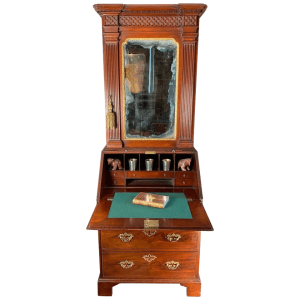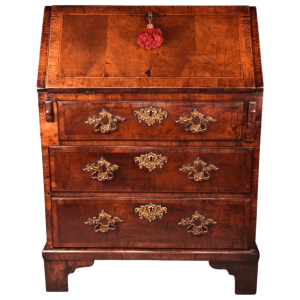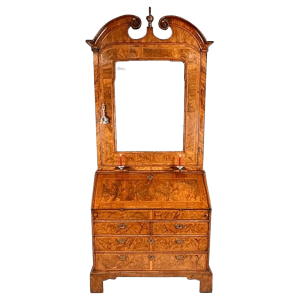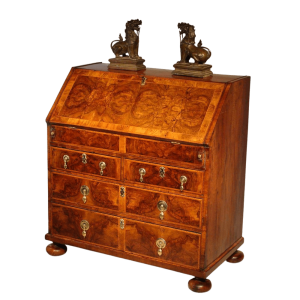Bureaux
17th – 19th centuries
Box House Antiques have always had a particular interest in chinoiserie antique furniture and English antique old furniture of Eastern influence. You will find examples throughout the website. Some are of Chinese export lacquer and others japanned in Europe. (A niche and highly sophisticated market). Coco Chanel's apartments in Paris were full of oriental 'japan' work - do take a look... Box House Antiques has a selection for you to choose from, in mahogany, walnut and now a rare small secretaire in satinwood attributable to Gillows. The bureau gradually acquired a superstructure, the earliest appearing ca 1660, with glazed or blind doors, and further on into the eighteenth century famous cabinet makers such as Chippendale created magnificent versions. The bureau or desk as we have come to know it did not appear in its present form until the mid- to late- 17th century, and remained fundamentally in this form right up to the present day to be found in almost every antique shop and for sale online. (Most dating from the Georgian period). Box House Antiques usually has a few bureaux for sale… mostly with interesting individual features. The French refer to a 'bureau plat' which consists of a flat top writing table usually with working drawers in the frieze. Later, bureau means 'a place of work' or 'office'. Americans even refer to the FBI as the 'Federal Bureau of Investigation'. A 'bureaucrat' is a mildly derogatory term referring to those preoccupied with petty correctness. Prior to becoming a 'bureau', a simple small portable oak box (often initialed and dated), with hinged top and lock to contain papers. Remember many were illiterate at this time. Gradually this box was placed on a chest of drawers, or on legs, and eventually morphed into the bureau we all recognise - probably one of the most common and affordable of all items of antique furniture available today. A bureau always has a fall-front writing slope, a secretaire has a pull-out writing drawer. Both often referred to as a 'secretary' in the US. In the 17th century most bureaux would have been made in domestic oak or walnut. With the imports coming into England ca 1680-1720, fine and rare veneers appeared to be applied on oak or pine carcasses. Some were decorated in the Oriental style (in England referred to as 'japan work’), lacquered, or even inlaid with complex marquetry. Occasionally they appeared in yew, oyster and burr woods, satinwood and other available exotic wood veneers. Mahogany and oak were the most commonly encountered. Bureaux and other items of European furniture were also exported to China on sailing ships to be lacquered and re-exported for the European market. Black & gold was the most usual, with red, cream, blue and green grounds being the rarest. All costly and highly sought after.












